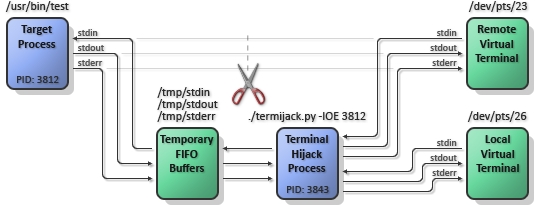TermiJack hijacks the standard streams (stdout, stdin, and/or stderr) from an already running process and silently returns them back after finishing. While this script is running and attached to another process, the user may interact with the running process as if they were interacting with the original terminal.
This script also provides the ability to mirror hijacked streams. In the case of standard input, this means that inputs from both this terminal and the remote terminal will be forwarded to the target process. Similarly, standard output and error coming from the target process will be forwarded to both this terminal and the remote terminal.
While gdb is being used to hijack standard streams, there may be a small latency during the transition where the target process is paused. Do not use this script on time-critical processes. Also, this script may need to be run as root in order for gdb to do its business.
Lastly, this script performs poorly with programs using either the ncurses or readline GNU libraries due to the special way they interact with input/output streams. Support for them may be added in the future.
Requires the GNU Debugger (gdb) in order to run.
Typically, the standard streams (stdin, stdout, stderr) are connected to a
virtual terminal like /dev/pts/23 as show below:
Using gdb to intercept the target process, we can use syscalls (open, fcntl) to create a set of named pipes that will act as the intermediate socket between the target process and the hijacker script. Other syscalls (dup, dup2) are used to clone the original standard streams to temporary place-holders and to swap the file descriptors of the named pipes and standard streams.
In the situation where we only hijack the standard streams and don't reflect the to/from the original streams, this setup looks something like the following:
The termijack script also allows the ability to mirror the standard streams to/from the hijacked process. This means that the hijacked stdin and hijacker's stdin will be multiplexed to the target process. Additionally, and stdout or stderr coming from the hijacked process will be sent to both the hijacked virtual terminal and to the hijacker's virtual terminal. This setup looks something like the following:
Of course, at the very end, when the termijack script detaches from the target process, it will undo all of the shenanigans and close file descriptors that it opened. Ideally, it's operation should be very surreptitious.
Hijack stdin, stdout, and stderr:
./termijack.py -ioe $TARGET_PID
Hijack stdin, stdout, and stderr. Also, reflect them back to the target process:
./termijack.py -IOE $TARGET_PID



